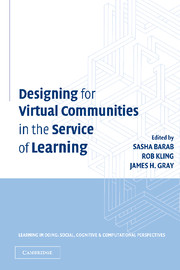Book contents
- Frontmatter
- Contents
- List of Contributors
- Series Foreword
- Foreword
- Preface and Acknowledgments
- In Memoriam
- PART I COMING TO TERMS WITH COMMUNITY
- PART II DESIGNING FOR WEB-SUPPORTED COMMUNITY
- PART III FOSTERING COMMUNITY/MEMBER PARTICIPATION
- PART IV RESEARCHING ONLINE COMMUNITY
- Index
- Titles in the series
Preface and Acknowledgments
Published online by Cambridge University Press: 05 June 2012
- Frontmatter
- Contents
- List of Contributors
- Series Foreword
- Foreword
- Preface and Acknowledgments
- In Memoriam
- PART I COMING TO TERMS WITH COMMUNITY
- PART II DESIGNING FOR WEB-SUPPORTED COMMUNITY
- PART III FOSTERING COMMUNITY/MEMBER PARTICIPATION
- PART IV RESEARCHING ONLINE COMMUNITY
- Index
- Titles in the series
Summary
This volume brings together a series of chapters focused on the theoretical, design, learning, and methodological questions with respect to designing for and researching virtual communities to support learning. We are at an interesting time in education and technology, with terms such as communities of learners, discourse communities, learning communities, knowledge-building communities, school communities, and communities of practice being the zeitgeists of education and the Internet serving as a much touted medium to support their emergence. More generally, any time a new technology is introduced, it suggests the promise of the revolution of education. Thomas Edison was convinced that film would transform education and make the teacher obsolete. Although the Internet offers much promise and the potential to support new environments for learning, we are just beginning to understand the educational potential of community models for learning and whether community can be designed online or face-to-face. In fact, we know very little about whether something such as community can be designed and, if so, whether this can be done online. We are witnessing instructional designers employing usability strategies effective for understanding human-computer interactions, but we have little appreciation of how to design to facilitate sociability – that is, supporting human–human interactions as mediated by technology.
Information
- Type
- Chapter
- Information
- Designing for Virtual Communities in the Service of Learning , pp. xvii - xxPublisher: Cambridge University PressPrint publication year: 2004
